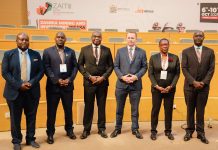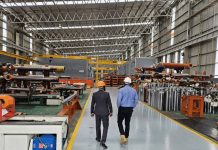One of the newest and most advanced copper smelters in the world is not in China or Canada or the United States, but right here in Zambia. This $900 million marvel of technology, which started operating in early 2015, is situated at First Quantum Minerals’ (FQM) Kansanshi Mine in North-Western province, just outside Solwezi.
The smelter was tailored to Kansanshi’s own design specifications and built in record time. It was brought to full production in an unprecedented five months. Thanks to its superior technology and processes, it has an annual production capacity of finished copper anode that ranks it among the top smelters in the world.
The new smelter has impeccable environmental credentials: it efficiently converts its sulphur dioxide off-gas (a by-product of the smelting process) into sulphuric acid, which is a vital chemical ingredient in the treatment of oxide copper ores. This recycling means Kansanshi gets over a million tonnes of “free” acid every year – a substantial seven-figure saving, given that acid costs around $150 a tonne on the open market, if available. Kansanshi now operates the largest single metallurgical off-gas sulphuric acid plant in the world.
“Acid was the real driver behind our decision to build the smelter,” says Simon Hunt, one of the Kansanshi engineers who played a key role in the design. “We also had a huge stockpile of smelter-grade copper concentrate – around 200 000 tonnes – that we couldn’t turn into finished copper because of a lack of smelting capacity in the region.”
A smelter is essential when copper is produced from sulphide-copper concentrate, but not every mine needs its own smelter. It is a massive investment, takes years to design and build, and is expensive to operate and maintain.
That’s why most copper mines in the world limit their mining activities to extracting copper ore from the ground and taking it through the first stage of processing until it emerges as copper-sulphide concentrate – a greyish-black powder that contains around 25% copper. The concentrate is then transported to the nearest smelter to be turned into finished copper, at an agreed smelting fee.
“Although most copper mines don’t require their own smelter, there was a compelling case back in 2011 for Kansanshi to build one,” says Hunt. “Firstly, Kansanshi’s production of copper concentrate was rapidly increasing. Secondly, FQM’s new Sentinel copper mine in nearby Kalumbila was under construction and would soon be producing copper concentrate. And thirdly, there was an urgent need for acid to treat oxide copper ore in our processing plant.”
The smelter was brought to full production in an unprecedented five months
The year was 2011. The decision to build the smelter had been approved by the FQM board. Kansanshi swung into action. The smelter wasn’t purchased “off the shelf”, but was built to very tight design specifications. Kansanshi sent three of its top engineers to Canada to liaise directly with the engineering design company there; the trio – Simon Hunt, Lawrence Hanschar and David Devries – have a collective 80 years of global experience in the design and operation of smelters. They worked right through the design, construction, commissioning and start-up of the smelter.
“We were embedded in Toronto during the entire design phase, which is not always the case,” recalls Hanschar “We were intimately involved in the design of every single part of the smelter – right down to the positioning of pipes, stairs and walkways.”
The smelter design was completed within two years – quick by world standards. Given the scale of the project and the tight deadline for completion, Kansanshi brought in the best skills it could find – both locally and internationally – to ensure construction happened quickly, safely and to the right standards.
The workforce wasn’t the only international aspect of the project; the technology was too. The smelter’s specialised equipment comes from 11 different countries – Canada, Finland, Germany, Australia, South Africa, the United Kingdom, China, Malaysia, Turkey, Indonesia and the Philippines.
The construction of the smelter ran from 2012 to early 2015, and represented a mini-economic bonanza for Solwezi. It provided work for well over 3 000 Zambians – from mining contractors to builders. The resulting injection of cash and salaries into the local economy had a significant multiplier effect on employment and the growth of new businesses, shops and supermarkets.
“By March 2015, the smelter was fully operational and producing its first copper – just over 5 000 tonnes,” says Hanschar. “Five months later we were up to 23 000 tonnes a month, just shy of the maximum rated capacity. That rapid ramp-up was unprecedented by world standards. We surprised even ourselves.”
It took barely five months from the start of smelter operations for Kansanshi to use up the entire 200 000-tonne stockpile of copper concentrate that had been lying around, not earning any money for the mine – or the country.
By August 2016, the smelter was treating equal proportions of copper concentrate from Kansanshi and Sentinel, and comfortably turning out 28 000 tonnes of finished anode copper a month. The smelter played a key role in Kansanshi’s excellent 2016 financial results, when the mine produced some of its best quarterly production figures and again emerged as the mining industry’s largest taxpayer – contributing $168 million (K1.75 billion) in 2016 in Mineral Royalty Tax and corporate income tax.
The strategic significance of the smelter cannot be understated. Firstly, given that North-Western province’s three copper mines already produce more than half of Zambia’s copper, it seems only fitting that the region should finally have its own smelter.
Secondly, when combined with the country’s other smelters (at Chambishi, Mopani and Konkola Copper Mines), the new Kansanshi smelter entrenches Zambia’s position as the African country with the largest installed copper-smelting base – ahead of South Africa, and even further ahead of the Democratic Republic of Congo, the continent’s largest copper producer. The four smelters give Zambia the ability to produce around 1.2 million tonnes of finished copper a year – comfortably above current production levels of around 750 000 tonnes a year.
However, given the current upswing in the copper price as global copper demand starts to take off again, this margin of safety is not likely to last very long – barely five years, assuming a modest 10% year-on-year annual increase in copper production.
“Mining is a long-term business, and the industry needs to start investing in future smelter capacity now,” says Hanschar.
Kansanshi’s smelter was designed to be expanded; tie-ins have been installed and areas for future equipment already allocated. A further big investment would enable its production capacity to rise from the current 300 000 tonnes of finished anode copper a year to 500 000 tonnes or more. However, this decision has to be weighed against the risks currently clouding the investment horizon in Zambia – notably the continued high overall tax burden on the industry, and the critical lack of an affordable, reliable supply of electricity. When the decision to build the smelter was taken in 2011, these factors were less of an issue, and the investment climate was therefore a lot more favourable.
These constraints notwithstanding, the success of the Kansanshi smelter demonstrates yet again the importance of long-term thinking and bold investment decisions in the survival and growth of the Zambian mining industry.























